 |
||
|
||
| ||
Our readers may be already familiar with VIA Eden — a project launched almost two years ago. This project intended a platform, which would have retained x86 compatibility (so that it could use the accumulated wealth of operating systems and software for this architecture), but would have possessed tiny dimensions, unusual for a PC, and low heat emission on the sufficient for certain use functionality level. I'll remind you that the first generation of this platform can be regarded as a suitable low price workstation. Its pros included sufficient performance for usual office operations, small size and the lack of fans in the cooling system. The second generation — VIA EPIA-M — was oriented for multimedia usage and was almost brilliantly coping with this task. The only serious drawback of this model with a 933 MHz CPU to our mind was a need for active cooling. What's the next objective to aspire? Raise the Eden CPU performance? I don't think so. C3 1 GHZ is quite sufficient for typical multimedia applications (the most consuming tasks — DVD and MPEG4 playback). Of course there always exist tasks (be it archiving or retouching a large photo in a graphics editor) which you want to be done faster. However these tasks as a rule do not have a cherished threshold of «real-time operation», which achievement can be highlighted in advertisement. HD Video is sure to come into our life in due course, but it will take some time, and we don't know when there appear computers capable of running this video format (C3 2 GHz will be obviously insufficient...) On the other hand, performance gain results in increased heat generation, and there is obviously a far cry between passive and active cooling systems in a tiny system. VIA took the path of further miniaturization of its already small platform, and in spring 2004 it announced a new nano-ITX form factor, the EPIA-N mainboard in this form factor, and the Eden ESP N processor of the corresponding tiny size. This device was mature enough for the mass production by the mid summer, and today we have an opportunity to present it to our readers. General Characteristics and Features
Our lab obtained EPIA-N8000:
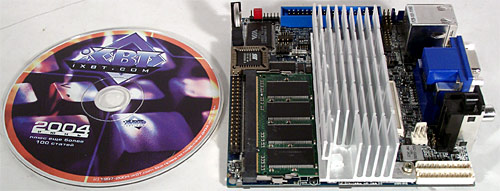
A mainboard sized 12x12 cm can hardly be miniaturized further — it just doesn't make sense until we abandon CD/DVD drives for full-sized discs (120 mm in diameter), because this drive is the largest element in the system. By the way, what case will match EPIA-N?
The most wonderful mainboard, which will have to be inserted into standard cases available on the market using a system of braces, counterbalances, and a welder, will not be popular on this market. In fact, the lack of infrastructure was the main deterrent of the popularity of the Eden platform with its mini-ITX form-factor right after the press release. In due course this gap replenished and there appeared cases for all tastes — from extremely pretentious to quite cozy little boxes of the notorious office color. Upgrade capacity with cards and planks, circumspective low-power supply units… And here we are starting everything from scratch for nano-ITX! Funny, even a mini-ITX voltage changer PCB (subsidiary by nature) is larger than our little one.
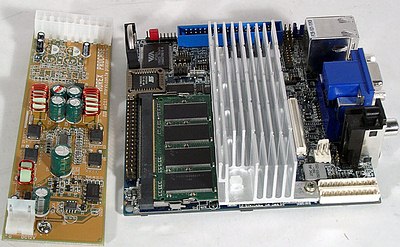
We'll wait and see the progress in this field, but anyway, EPIA-N will not be left without its infrastructure: the spring CeBIT 2004 exhibited an assembled PC Nanode designed by Hoojum Designs (dimensions — 15x16x9,5 cm). In addition the VIA web site contains information about several other concepts.
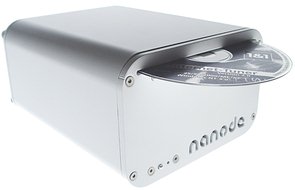 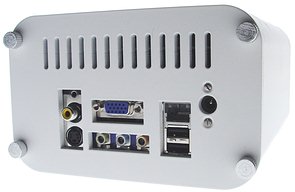
We don't know yet for sure what the EPIA-N package will contain, but judging from our experience we can presume that it will comprise only bare necessities (box, guides, CD with drivers, etc, several cables). What else is necessary to work with this miniature platform? Let's first determine what is embedded into the mainboard.
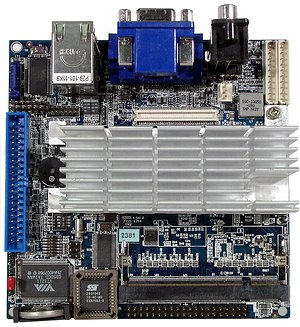 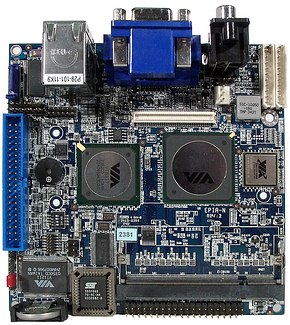
The first to mention is obviously a subminiature VIA Eden ESP N processor (in our case — 800MHz with the FSB frequency at 133 MHz, and the future models of the nano-ITX form factor may use 1GHz Eden ESP N or newer processors at the 200 MHz FSB). Per se, it's the Nehemiah core (we are already familiar with it) in a unique nanoBGA package with 324 pins (in comparison with 370 pins in the existing Eden ESP) and a very small base (its size is just 15x15 mm — this can be afforded only if the CPU is permanently installed right on the PCB instead of the socket installation). Brief reminder — the Nehemiah core features 64 KB L1 cache (data/instruction) and an integrated L2 cache, enhanced FPU and the SSE instructions support. As a result, C3 Nehemiah can seriously compete at least with an equifrequent Celeron «Coppermine» if not with Pentium III. In the 8th revision (stepping) of the Nehemiah core, they managed to reduce its size (from 52 to 47 mm2) and supply voltage (from 1.4 V to 0.8—1.05 V depending on the clock frequency) and to add APIC — this particular version underlay the Eden-N processor (as it will be referred to for short).
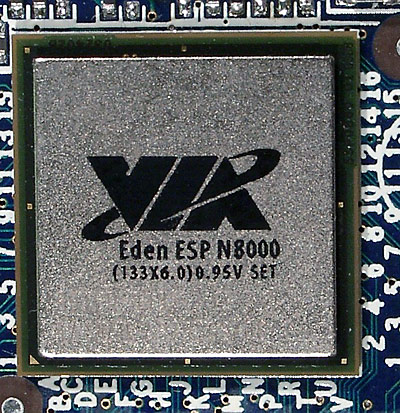
The Eden ESP N8000 processor tested in our lab operates at 0.95 V and releases 5 Wt in its loaded state. According to VIA, this level of heat emission does not necessarily require active cooling, and we would be very glad to agree to the company in this point — who needs an extra cooler. In theory even a 1GHz Eden-N with its 7 Wt can do with just a heatsink. Maximum operating temperature for all Eden ESP processors in EBGA and now in nanoBGA package is 85°C.
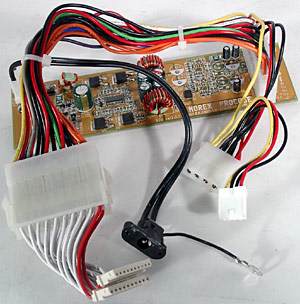 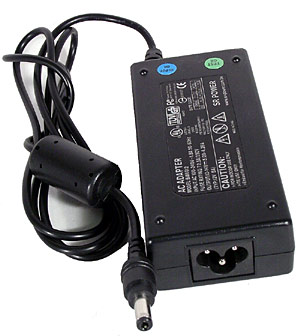
To test EPIA-N we used a 60 Wt external supply unit with no fan (with large power reserve for this system). For voltage conversion we used a board from a mini-ITX case, and an ATX to nano-ITX power adapter. Yes, they even modified the power connectors in the new standard.
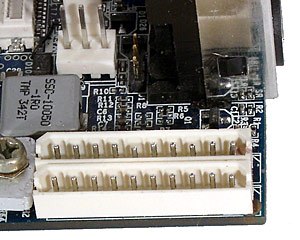 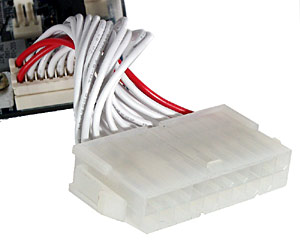
EPIA-N uses the VIA ŃN400 chipset with an embedded graphic AGP-core UniChrome Pro and the VT8237 south bridge. The north bridge of the chipset is designed for the AGTL(+) (Socket 370) CPU bus and DDR memory (up to 1 GB DDR200/266/333/400). As we have already seen in EPIA-5000 tests, for its operation the embedded video accelerator requires the DDR memory even with 133 MHz FSB (its throughput is 1 GB/sec). The memory volume limit mentioned above is dictated by the PCB circuitry only for a single SODIMM slot. By the way, memory modules of this type are only a little more expensive than common DIMM, so you will not overpay to memory. Note that CN400 supports the 200 MHz FSB, and it's expected that new C3/Eden ESP CPUs will be released soon for this FSB.
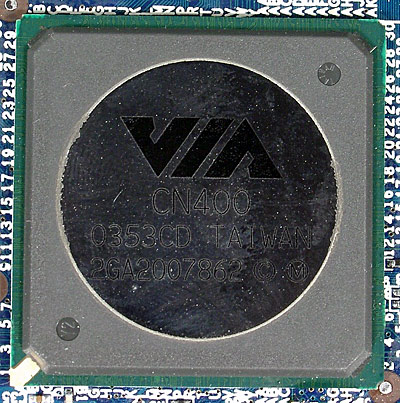
VT8237 is the latest VIA south bridge, so one cannot complain about its functionality. Besides, it is connected to the north bridge with the Ultra V-Link (1 GB/sec) bus, that is its throughput is also all right. It supports the Fast Ethernet network controller (using the external PHY VT6103), 4 ATA133 and 1 SATA device, 6 USB 2.0 ports (2 ports are on the back panel, plus a connector for the back plate with another 4 ports), 6-channel sound (external VT1616 AC'97-codec), PS/2 mouse and keyboard (there are no ports on the back panel, just a PCB connector to plug the cords), FIR (Fast InfraRed). Both IDE connectors on the PCB have a full set of pins (required for special flash disks), so in the modern ATA66-stubs you will have to make a hole (with a piercer) opposite to one of the pins. Some (future?) EPIA-N versions provide for DOC (Disk-On-Chip) with an option to boot from it, but our sample did not have this option.
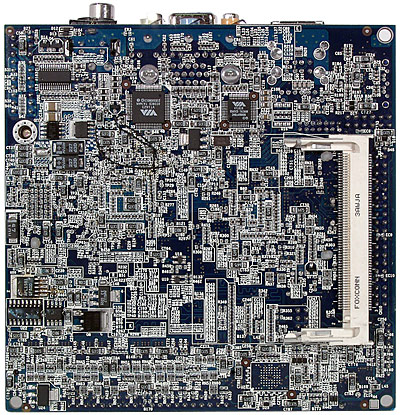
The board does not have a floppy connector, and the expansion capacity is limited to a single mini-PCI slot on the back side of the PCB. The other trivia include a fan connector and CD-In. Pay attention to the point-to-point wiring — this is characteristic of reference samples, there will be no such things in production boards of course.
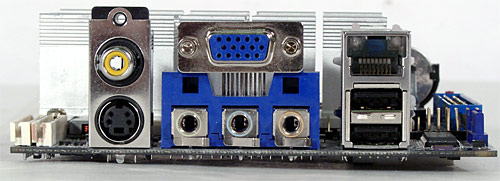
There is little room for the plate with connectors on the back panel, so they had to sacrifice some standard connectors (in our case, the board lacks PS/2 ports, serial and parallel ports at the least). In return, in addition to an analog output for a monitor (D-Sub) it features S-Video and coaxial output (can be used to output video or as S/PDIF-Out, the mode is selected by a jumper on the board). 3 analog sound connectors provide for 6-channel sound (this functionality is configured in drivers). Network socket and 2 USB ports complete the picture. Note the overall compactness of the board — its height does not exceed 3.5 cm from the PCB surface.
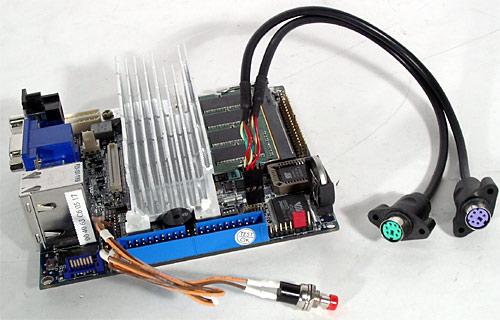
Video Core and TV-OutEmbedded video in all the previous AVI chipsets was too weak for 3D-games, at we couldn't expect any breaks on this front — the company rather focuses on video out features. CN400 is based on the UniChrome Pro core at 200 MHz, 128bit, two pixel pipelines and one shader pipeline — it's a last century solution. Add traditional problems with OpenGL drivers and the impressive 31 points in 3DMark03 (1024x768x32, 4,3 fps in the only playable game test (the first one)) — and you will get an idea of EPIA-N gaming capabilities. Remember that there is no AGP slot on this board, and we have heard nothing about video accelerators on mini-PCI. However, the 2D quality of the sample, tested in our lab, turned out quite decent in 1280x1024x32 at 85 Hz (1600x1200x32 only at 60 Hz) on a 17" Samsung SyncMaster 757 DX. A more interesting feature is hardware acceleration of MPEG2 (useful for DVD playback) and MPEG4 decoding. In case of MPEG4, the hardware performs iDCT and GMC (global motion compensation) L0/L1. And don't forget about TV-Out. Signal is encoded by the most «advanced» VIA chip — VT1623 supporting SDTV, PAL/NTSC standards, and resolutions up to 1024x768. The video is produced via S-Video or RCA Video (when this coaxial output mode is selected by a jumper on the PCB). Video output can be assigned in BIOS Setup with the following options available: CRT/TV/CRT+TV/LCD/CRT+LCD (pay attention: LCD — is an LVDS interface mode, but for an LCD monitor connected via D-Sub you should select CRT). You can also select there a transmission standard (PAL/NTSC) and video signal output (S-Video, composite, YCbCr or SCART (RGB), and SDTV modes). Much progress has been made since EPIA-M, today's CRT+TV options in BIOS allow to use a monitor or a TV set as interchangeable output devices, thus you won't have to use a monitor to set up TV-Out. With one exception however: if you use an LCD monitor connected via D-Sub (not via the LVDS interface), you will probably not be able to watch the process of computer and OS startup, because the screen refresh frequency at these moments is 50 Hz (for TV set compatibility), and LCD monitors may inadequately react to this unsupported frequency. The chipset specifications state the capability to output two different images at different refresh frequencies and resolutions simultaneously to two different output devices. The sample in our lab with the latest drivers could copy images and stretch the desktop to two displays. The quality of TV image was very high in case of S-Video connection, but when connected via RCA Video we didn't manage to get a stable and crisp image. However we didn't use TV-sets or panels with a large diagonal line in our tests, so let's not jump at conclusions in the area of high-quality video output. The board contains an extension slot, implementing the remaining functionality of the chipset video core (2 ports for video capture), and a video output to the built-in LCD monitor via the LVDS transmitter. The bundle did not contain an extension card. BIOS, Monitoring, Cooling, Temperature ConditionsThe EPIA-N sample in our lab had BIOS v0.05. 2Mbit BIOS is based on a «classic» version of AwardBIOS 6.00 PG from Phoenix. Its current version does not offer any overclocking options. The settings that influence the overall performance include memory frequencies (DDR200/266/333/400) and a large number of RAM timings, AGP parameters (including the one for embedded video buffer) and vague V-Link bus mode switching (between chipset bridges). Out of other BIOS features I'd like to mention the ability to disable any embedded controller, wake on PS/2, USB, PCI, LAN/Ring and a timer, as well as booting from CD/DVD drive, HDD, USB-FDD, USB-ZIP, USB-CDROM and LAN. In the last case the system will use Boot ROM of the on-board network controller and you will have an option to boot up from a network device. Interestingly, according to the documentation the Eden-N CPU's multiplier is not blocked — it is specified by the board at system startup or is set by resistors/switches on the PCB. Moreover, with special software you can make the Eden-N processors change their multiplier dynamically — this VIA technology is named "PowerSaver" being actually a modification of well-known Intel SpeedStep and AMD Cool'n'Quiet. However, in this case we didn't manage to influence the multiplication factor of the embedded processor. BIOS contains a spare of functionality section for monitoring critical system parameters. It monitors CPU temperature (? — the option is named "Heatsink Temp", and judging from its readings right after overheating reboots, if it monitors the CPU thermodiode, it does it in a strange way) and CPU voltage, 3.3 and +12 V. Unfortunately, even the programs supporting the VIA VT1211 monitoring chip in Windows didn't manage to take correct readings from sensors.
We have mentioned overheating deliberately: the system was constantly overheated operating in an open test bench (without any case) in a room with the temperature about 20°C. Maximum registered uptime (after complete cooling) is about 15 minutes, but active applications considerably reduced this time (to say nothing of RMMA — it just «killed» the system in a minute's testing time). We can't point out the reasons for sure. The heatsink and «bare» memory chips at the "freeze" point were burning hot by touch. Considering the drastically reduced times between system reboots/freezes during memory tests, we can well suspect SODIMM overheating. However, CPU is a more likely contender.
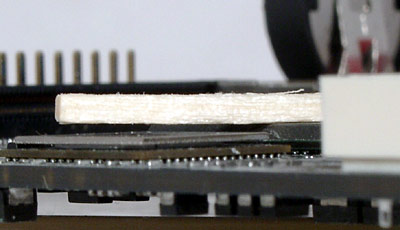
On the photo above you can clearly see the gap between a match lying on the northbridge chip and a CPU surface. This miniaturization is obviously harmful to the low-profile processor, while the chipset crystals collected under a common heatsink are of the same height and thus have no problems. It's not clear why VT8237 needs a heatsink while mainboards from most manufacturers are doing fine without it. Perhaps it's a sheer technological solution resulting from the lack of room for the different layout and dimensions of the cooling unit.
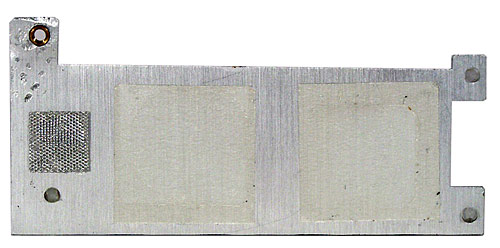
This way or another, the problem with a gap between a CPU and a heatsink must be resolved, and for this purpose VIA uses a relatively thick insert made of several layers of fine metal woven fabric soaked with hot adhesive. Of course, we cannot judge the quality of thermal contact by its appearance, but this insert cannot possibly have beneficial impact. We'll wait for the production samples, where VIA promised to use a different heatsink, and then it'll be safe to say whether there are problems with passive cooling or not. Performance AnalysisIt's a short and qualitative study (meaning, it does not aim to get exact figures). We have already mentioned games in this review — VIA offers nothing new in terms of embedded video accelerators. EPIA-N8000 made a good show as an internet-client and an office workstation, that is we don't have any claims to the speed of switching between applications and performing simple operations (the «test methods» are described in detail in the previous reviews of the Eden platform). A newer core (even relative to EPIA-M) at 800 MHz is quite enough for such tasks. Video playback. It's more interesting, but still, you cannot expect jiggery-pokery from DVD, as the new chipset will hardly decode MPEG2 worse than the old one, and we had no problems at all watching DVD on EPIA-M9000. Decompression and rendering speeds are sufficient, memory throughput is over the odds. But PowerDVD XP 5.0 somehow managed to load 90—95% CPU (perhaps the CPU was loaded for processing the 6-channel sound). For video playback in the MPEG4 format we traditionally used a quick free BSPlayer (v1.00.809). Filters and decoders were chosen individually for each video clip. We tried a lot of clips with various bitrates, from different encoders, and in different formats. The results we obtained were expectable for an 800 MHz VIA C3 on the Nehemiah core. All the clips were played without jerking and frame drops, but at the cost of reduced postprocessing quality or initially reduced quality (resolution or bitrate). We never enabled the maximum level of postprocessing effects in DivX 5.1.1 (we selected video clips of relatively high quality). The MPEG4 decoder from Microsoft just doesn't offer any postprocessing settings, but even clips with a high bitrate were played back without any problems. So, EPIA-N8000 does not probably qualify for a cinemaddict's dream, but it irreproachably plays DVD and it gets a straight B for playing popular clips and movies in MPEG1 and MPEG4. Note that we have benchmarked all memory modes from DDR200 to DDR400 and found out no visual difference, so the low-cost DDR266 modules will be quite sufficient for the above-mentioned tasks. ConclusionsEPIA-N is a step forward in the series of miniature computer systems. The dimensions are considerably smaller, performance is higher (with the same CPU clock frequency), it is sufficient for consistent playback of MPEG2/MPEG4 video, it contains no fans. Plus USB 2.0, SATA, TV out, and modern audio features. In addition to the above, a new platform with enhanced functionality (EPIA-NII) is expected at the end of the year. But the ultimate happiness requires two conditions. Firstly, the overheating problem must be solved. This is a must. Secondly, the nano-ITX infrastructure should appear on the market. Cases (Many! and with well-designed system of leading out interface connectors from the extension cards!), supply units and/or power adapters of the corresponding dimensions and power, mini-PCI extension cards (various!), etc. Everything necessary for a common user, who doesn't know which end of the soldering iron to hold. It goes without saying that the price factor always remains. The only available information was provided by VIA in spring, and we doubt that the announced $399 for EPIA-N (we don't know the CPU) will actually take place. Subminiaturization and passive cooling are great, but not for this price!
We would like to believe in the nano-ITX future, because in this case a new promising series will join the ranks of tiny PCs, and the entire species will make another step to the masses. Anyway, EPIA-N certainly merits our Original Design award.
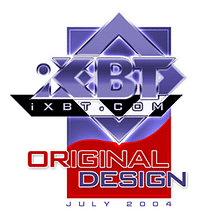
VIA EPIA-N on the manufacturer's web site
Write a comment below. No registration needed!
|
Platform · Video · Multimedia · Mobile · Other || About us & Privacy policy · Twitter · Facebook Copyright © Byrds Research & Publishing, Ltd., 1997–2011. All rights reserved. |